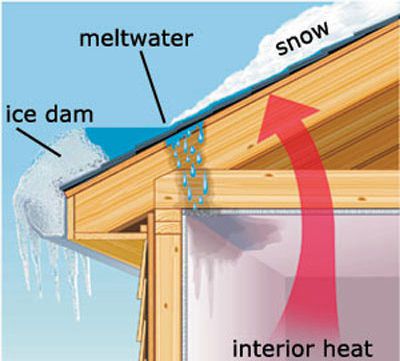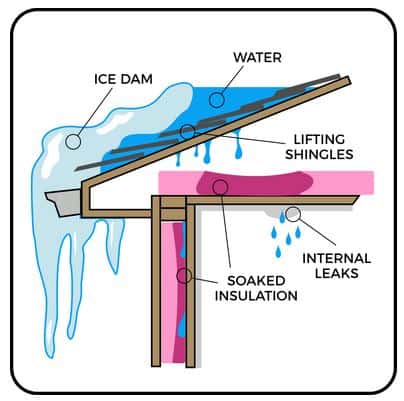As autumn draws to a close and temperatures continue to steadily drop in many areas around the country, homeowners must ready themselves for the oncoming snow and ice of the winter season. For homeowners in areas with colder climates, these preparations include stocking up on salt for the driveway, replacing broken snow shovels or tuning up snow blowers. For many, these preparations also include looking to avoid the formation of ice dams along the roofline.
What Is An Ice Dam?

If you live in an area of the country with a more temperate climate, and experience snow and ice through the winter months, then you’ve seen your fair share of ice dams. You know, those beautiful cascades of glittering icicles hanging from the edges of roofs? Those are ice dams.
An ice dam is a build up of ice gathered along the roofline of a home that is formed when snow collects and builds up on your roof in below-freezing temperatures. Once this snow melts and slides down the roof due to the sun’s heat, a mixture of ice and water work it’s way beneath the shingles and into the home, causing expensive damage to the wood, sheetrock, insulation and more.
The snow will naturally melt due to the sun, but the process is often sped up by heat loss from living spaces within the home, into the attic, a problem often associated with a lack of proper insulation and air sealing.
What Can Ice Dams Do to the Home?

The greatest enemy to homeowners around the world is water, which is what creates major issues when ice dams start to cause damage. When it comes to managing water, it’s best to understand that is it quite destructive in both it’s liquid and solid state.
As ice melts and re-freezes, it can create a surprising amount force against your gutters and shingles, which can lead to the point of ripping the gutters off the roof entirely, and loosening or curling shingles. Snow melt, if unimpeded by shingles and with no proper way to drain from the roof, can cause damage not only to the roofing material, but also the structural components of the home, as it pours into the attic. This can ultimately lead to moisture problems such as mold and mildew, and often0 spreads through a home very fast.
How To Prevent Ice Dams?
While there are many products and procedures sold as the best way to prevent ice dams, one of the most reliable ways to stop ice damming is through proper insulation and air sealing practices, which can be done by an experiences insulation contractor.
When a home is constructed, it’s common to have gaps and cracks left behind, including:
-
Nail and Screw Holes
-
Plumbing & Electrical Penetrations
-
Around Chimneys and Vents
-
And more
Your attic, like any other part of the home, will have these gaps and cracks as well. These small holes can allow warm air from the living spaces to escape up into the attic and up to the roof. This causes an increase in temperature which melts the snow and ice above on the roof thus creating ice dams.
Ice dams can be prevented by using proper insulation and air sealing techniques, to keep warm air inside the living space and prevent it from escaping. This is the most effective way to prevent the formation of ice dams.
-
Air sealing is the practice of filling the many small gaps and cracks with an expansive foam insulation material. This insulation material, once injected into the gaps and cracks, fills them completely to stop air from escaping from living spaces and moving into cooler areas, and has the added benefit of being waterproof, providing some added security against snowmelt and rain.
-
Proper insulation practices are also a must to prevent ice dams. Using one of a variety of insulation materials such as cellulose, foam board, or spray foam a home insulation contractor is able to create a barrier between both the attic and the roof, and the attic and the living spaces below, effectively blocking the flow of air from living spaces, and acting as double insurance against ice dams and cold indoor temperatures.
How Do You Get Rid of Ice Dams in Gutters?

Dealing with ice dams in your gutters can be a major pain, but there are ways to remove them. When ice collects in your gutters, it should be addressed ASAP! Since gutters are thin, they can break when too much ice has accumulated in them, either by bending from the weight or splitting the seams. Here are a few quick ways to get rid of, remove, and melt ice dams from your gutters:
- Use Hot Water: As simple as this sounds, using hot water on your ice dam laden gutters is the quickest way to remove ice from your gutters. Gently run hot water across the gutters if you have the ability to do so to quickly melt the ice in the gutters.
- Install A Gutter or Roof Heater: A gutter or roof heater system is an easy way to remove and prevent future ice dams from building in your gutters. Learn more about roof and gutter heating here. *install button to shop*
- Remove Snow: This is an often overlooked solution when it comes to preventing ice dam build up in your gutters. As they say, prevention is the best medicine, and when it comes to preventing ice dams from forming in your gutters, removing snow as soon as you can is the best way to do so. The safest and most efficient way to remove snow off your roof is with a roof rake, which can be found here.

